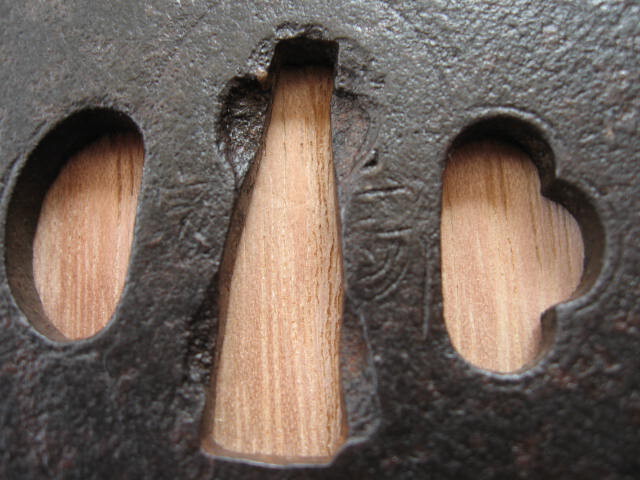-
Posts
4,118 -
Joined
-
Last visited
-
Days Won
31
Content Type
Profiles
Forums
Events
Store
Downloads
Gallery
Everything posted by Grey Doffin
-
This person who has sharpened Japanese swords before, who will remove the grinder marks from your sword, is he a properly trained polisher or something else? This sword may be salvageable and it might be worth the expense of the salvage, but if the work is attempted by anyone other than a properly trained polisher you'll be wasting your money and possibly destroying the blade. Grey
-

WWII Mounts/Fittings
Grey Doffin replied to SwordGuyJoe's topic in Auctions and Online Sales or Sellers
And it's not a sure thing that the saya will fit either. Like Todd said, almost impossible to find a rig to fit your blade even if you can try it on. Online by way of photos and measurements, no chance. Grey -
The blade is much older than WWII; no doubt about that. I was commenting on the hand writing, nothing more. Grey
-
Nice looking sword and a good price if real, but I've never seen those papers before. Anyone know which organization issued them? Grey
-
The signature reminds me of Gunto signatures; it would look perfectly at home on an oil tempered blade from WWII. It looks, also, as if some rust has been removed inside and around the Kanji. Grey
-
Look at the work, not the signature. While there may be quite a few smiths with the same signature, for each of them, it the signature is legit, the work must match what he did. In an instance like this even the shinsa team might just paper the blade to the smith, without designating a particular smith out of that group. Darcy, How are you feeling? That must have been one painful operation. Grey
-
100% fake. Grey
-
Katana start at 2 shaku from the tip back to the notch at the back in a straight line. 2 shaku = 23.86" or 60.60cm. This measurement is called nagasa in Japanese. Grey
-
Thanks Ted. There is no evidence of any obscured characters above or below the 7, and the condition of this tsuba is good enough that I'd see something if that were the case. I agree with something shu and Mune; I thought of Myochin too. One thing I really like about this tsuba is the hammer work. Notice how the marks radiate out? Amida yasuri done with a hammer, not a file or chisel. Grey
-
Bugman This is what you're up against. This sword might be Koto, likely late Koto rather than early or mid Koto. This was a time of constant warfare in Japan, a time when there was great need for lots of weaponry. Swords were made by the bucketful; some of them were great pieces by great smiths but the majority weren't. If you get this polished and find out later that it is one of the mass produced blades of late Koto times, especially if it is a wakizashi and being unsigned, it will be worth much less than what you paid to have it polished and all you will have learned is to be more careful with your money next time. You need to have a better idea of its value, monetary and artistic, before you decide to throw money at it. A Kendo instructor isn't necessarily an authority on sword quality; he might know what he's talking about or he might know next to nothing. Show it to someone better able to advise you, a polisher at a Japanese sword show for example, before going further. Grey
-
No, just one. Looks like 7 to me. After I posted this I got to wondering if this tsuba hadn't been talked about on NMB before. I have faint recollection of a 7 on a tsuba discussion before. Grey
-
-
Soot with tape and pressure sensitive paper don't work very well to reliable draw the hamon and hataraki either. Grey
-
I haven't seen the contact sensitive paper for quite a few years now. Wasn't it some sort of medical device paper? EKG? But again, there is no reason to look for it. Real oshigata are easy! And fun and informative. You notice things about a sword when you take the time to do oshigata that you wouldn't see otherwise. Grey
-
I just received a tsuba in the mail that had been shipped in its box. Lucky for me and the tsuba it was wrapped in paper that protected it from serious damage. The picture below shows why you never want to transport tsuba in boxes. Grey
-
Not all swords have rayskin under the wrap. The mounts on your sword are lower quality and no rayskin was used. It isn't possible for any of us to tell you who made the sword without having it in hand, and even then probably not. What is the length of the cutting edge? If less than 24" it is an unsigned wakizashi in low end mounts, which doesn't point to anything great. Of course, any level of blade can be found in any level of mounts so you can't automatically assume the blade isn't worth a polish just from the mounts, but chances are not in its favor. I think you should put a very light coat of good machine oil on the polished portion (not the tang) of the blade, and otherwise let it be for now. If you're going to get serious about Japanese swords, in a few years after you learn much more, you can decide whether or not to get it polished. If you aren't going to get serious there's no reason to spend a couple thousand dollars on a polish you won't appreciate. Grey
-
Brian, My understanding, gained from those more knowledgeable than me, is that the soot will affect the nakago if left on, and that cleaning it off risks damage also. And like I said, there is no reason whatsoever to do a soot and tape oshigata. Is saving yourself 5 to 10 minutes with an ink stone worth the risk you might damage the sword? Grey
-
Not what you asked about but I notice that you've made a soot and tape oshigata. This isn't a good idea. The soot can alter the patina of the nakago, and if you clean off the soot you're cleaning the nakago which can alter the patina of the nakago. You want never to alter the nakago. Traditional oshigata, made with thin paper and ink stone, does a better job, isn't terribly difficult or time consuming, and won't damage the sword. Do yourself and your swords a favor and try it. Grey
-
I suggested the paper and tape fix rather than rice glue because it is much easier and therefore more likely to be done, and because it can't do any damage. I wouldn't suggest that someone with absolutely no experience should attempt to glue the handle, even with rice glue. The reason why I think you need to fix the handle is that the scabbard and handle provide the best protection for the blade. If the blade were knocked off the sword stand there is a high probability that it would break. Also, sitting out in the open it is more vulnerable to abuse (picked up and handled by someone who wonders if it will cut a bed post, for example). The paper/tape fix is really very easy to do; should take all of 5 minutes. The handle looks like it has a waist (narrow section in the middle). Wrap the paper here and wrap masking tape around the paper. Slide the paper one way until it will go no further. Repeat and slide the other direction. Voilla! The handle is now secure. Next you can whittle a pin to go through the hole in the handle and tang of the sword, and you're good to go. By the way, all you out there with sayas that are starting to split, this is an excellent fix for that problem also. Value? Maybe about $600 to $800 for the sword if it is as clean (in polish) all around as it appears in your pictures, and $250 for the tsuba. This is just a guess; I haven't seen the sword and markets change. Do check out the sword care site and be very careful with your sword. They break easily. Grey
-
Hi, Here's what you can do to fix the handle without doing any damage. Cut strips of paper about 1" wide and long enough to go around the handle 1 1/2 times. Wrap a strip around the handle at it's smallest diameter and tightly wrap masking tape around the paper. Now slide the paper and tape either up or down to a larger diameter. This will firmly band the 2 pieces of wood but it is reversible and will leave no mark when the time comes to have the handle properly repaired by someone who works with Japanese sword mountings. Once you have the handle in one piece you need to whittle a pin to lock the blade in the handle, through the hole in the handle. Chopsticks will do fine. Without a handle and pin through it the blade is very vulnerable to breakage (the point can get chipped in the bottom of the scabbard). Hope this makes sense. It is important that you do this soon. By the way, I agree with the reading of the signature and there is no doubt about this being a real Japanese sword. Grey
-
Hi Kyle, The dark mark in the 1st photo and in the other photo I looked at is shin-tetsu, core steel showing through. Surprising that it shows black in one photo and white in the others. Black is what I'd expect for shin-tetsu. Considering the bad kizu nearby in the picture it isn't surprising that the blade is tired. No cleaning or polish can help, and it doesn't really make sense to spend money on a blade in this condition anyway. Sorry for bad news. Grey
-
I have seen a fukure in the hamon. Don't have pictures, sorry. I was told at the time that it wasn't repairable because it was in the hamon. Grey
-

The ones that got away
Grey Doffin replied to Gabriel L's topic in General Nihonto Related Discussion
A couple monts back I was searching ebay and the 1st listing in my search was a real Nihonto, katana with a buy-it-now price of one sixty. I was a second or so too slow to be the one to get it. That was $1.60. Love to know the story behind it. Grey






